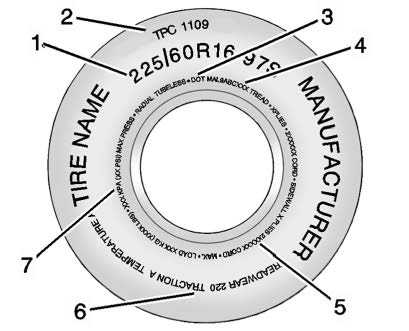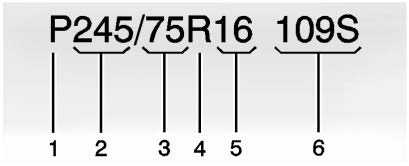Chevrolet Bolt EUV 2023 Winter Tires User Guide
Winter Tires
This vehicle was not originally equipped with winter tires. Winter tires are designed for increased traction on snow and ice-covered roads. Consider installing winter
tires on the vehicle if frequent driving on ice or snow-covered roads is expected. See your dealer for details regarding winter tire availability and proper tire selection. Also, see Buying New Tires 0 268. With winter tires, there may be decreased dry road traction, increased road noise, and shorter tread life. After changing to winter tires, be alert for changes in vehicle handling and braking.
If using winter tires:
- Use tires of the same brand and tread type on all four wheel positions.
- Use only radial ply tires of the same size, load range, and speed rating as the original equipment tires. Winter tires with the same speed rating as the original equipment tires may not be available for H, V, W, Y, and ZR speed-rated tires. If winter tires with a lower speed rating are chosen, never exceed the tire’s
maximum speed capability.
Self-Sealing Tires
This vehicle may have self-sealing tires. These tires have a material inside that can Seal punctures from common road hazards, such as nails and screws, in the tread area. The tire may lose air pressure if the sidewall is damaged or the tread puncture is too large. If the Tire Pressure Monitor System indicates the tire pressure is low, inspect the tire for damage and inflate it to the recommended pressure. If the tire is unable to maintain the recommended pressure, contact the nearest authorized GM servicing facility immediately for inspection and repair or replacement. To locate the nearest GM servicing facility, call GM Customer Assistance.
Caution
Do not drive on a deflated self-sealing tire as this could damage the tire. Make sure the tire is inflated to the recommended pressure or have it immediately repaired or replaced. When tire replacement is needed replace with a self-sealing tire, because the vehicle does not come with a spare tire or tire changing equipment.
Tire Sidewall Labeling
Useful information about a tire is molded into its sidewall. The example shows a typical passenger tire sidewall.
Passenger Tire Example
- Tire Size: The tire size is a combination of letters and numbers used to define a particular tire’s width, height, aspect ratio, construction type, and service description. See the “Tire Size” illustration later in this section.
- TPC Spec (Tire Performance Criteria Specification): Original equipment tires designed to GM’s specific tire performance criteria have a TPC specification code molded onto the sidewall. GM’s TPC specifications meet or exceed all federal safety guidelines.
- DOT (Department of Transportation): The Department of Transportation (DOT) code indicates that the tire is in compliance with the U.S. Department of Transportation Motor
Vehicle Safety Standards. - DOT Tire Date of Manufacture: The last four digits of the TIN indicate the tire manufactured date. The first two digits represent the week and the last two digits, the year. For example, the third week of the year 2020 would have a 4-digit DOT date of 0320. Week 01 is the first full week (Sunday through
Saturday) of each year. - Tire Identification Number (TIN): The letters and numbers following the DOT code are the Tire Identification Number (TIN). The TIN shows the manufacturer and plant code, tire size, and date the tire was manufactured. The TIN is molded onto both sides of the tire, although only one side may have the date of manufacture.
- Tire Ply Material: The type of cord and number of plies in the sidewall and under the tread.
- Uniform Tire Quality Grading (UTQG): Tire manufacturers are required to grade tires based on three performance factors: treadwear, traction, and temperature resistance. For more information, see Uniform Tire Quality Grading 0 269.
- Maximum Cold Inflation Load Limit: Maximum load that can be carried and the maximum pressure needed to support that load.
Tire Designations
Tire Size
The example shows a typical passenger vehicle tire size.
Passenger (P-Metric) Tire
- Passenger (P-Metric) Tire: The United States version of a metric tire sizing system. The letter “P” as the first character in the tire size means a passenger vehicle tire engineered to standards set by the U.S. Tire and Rim Association.
- Tire Width: The 3-digit number indicates the tire section width in millimeters from sidewall to sidewall.
- Aspect Ratio: A 2-digit number that indicates the tire height-to-width measurements. For example, if the tire size aspect ratio is 75, as shown in item (3) of the illustration, it would mean that the tire’s sidewall is 75 percent as high as it is wide.
- Construction Code: A letter code is used to indicate the type of ply construction in the tire. The letter “R” means radial ply construction; the letter “D” means diagonal or bias ply construction.
- Rim Diameter: The diameter of the wheel in inches.
- Service Description: These characters represent the load index and speed rating of the tire. The load index represents the load-carrying capacity a tire is certified to carry. The speed rating is the maximum speed a tire is certified to carry a load.
Tire Terminology and Definitions
Air Pressure: The amount of air inside the tire pressing outward on each square inch of the tire. Air pressure is expressed in kPa (kilopascal) or psi
(pounds per square inch).
Aspect Ratio: The relationship of a tire’s height to its width.
Belt: A rubber-coated layer of cords that is located between the plies and the tread. Cords may be made from steel or other reinforcing materials.
Bead: The tire bead contains steel wires wrapped by steel cords that hold the tire onto the rim.
Bias Ply Tire: A pneumatic tire in which the plies are laid at alternate angles less than 90 degrees to the centerline of the tread.
Cold Tire Pressure: The amount of air pressure in a tire, measured in kPa (kilopascal) or psi (pounds per square inch) before a tire has built up heat from driving. See Tire Pressure 0 261.
DOT Markings: A code molded into the sidewall of a tire signifying that the tire is in compliance with the U.S.
Department of Transportation (DOT)
Motor Vehicle Safety Standards. The DOT code includes the Tire Identification Number (TIN), an alphanumeric designator that can also identify the tire manufacturer, production plant, brand, and date of production. GVWR
Gross Vehicle Weight Rating. See Vehicle Load Limits 0 172.
GAWR FRT: Gross Axle Weight
Rating
for the front axle. See Vehicle Load Limits 0 172.
GAWR RR: Gross Axle Weight Rating for the rear axle. See Vehicle Load Limits 0 172.
Intended Outboard Sidewall: The side of an asymmetrical tire, that must always face outward when mounted on a vehicle.
Kilopascal (kPa): The metric unit for air pressure.
Light Truck (LT-Metric) Tire: A tire used on light-duty trucks and some multipurpose passenger vehicles.
Load Index: An assigned number ranging from 1 to 279 that corresponds to the load-carrying capacity of a tire.
Maximum Inflation Pressure: The maximum air pressure to which a cold tire can be inflated. The maximum air pressure is molded onto the sidewall.
Maximum Load Rating : The load rating for a tire at the maximum permissible inflation pressure for that tire. Occupant Distribution : Designated
seating positions.
Outward Facing Sidewall : The side of an asymmetrical tire that has a particular side that faces outward when mounted on a vehicle. The side of the tire that contains a whitewall, bears white lettering or bears manufacturer, brand, and/or model name molding that is higher or deeper than the same moldings on the other sidewall of the tire.
Passenger (P-Metric) Tire: A tire used on passenger cars and some light-duty trucks and multipurpose vehicles.
Recommended Inflation Pressure: The vehicle manufacturer’s recommended tire inflation pressure as shown on the tire placard. See Tire Pressure 0 261 and
Vehicle Load Limits 0 172.
Radial Ply Tire: A pneumatic tire in which the ply cords that extend to the beads are laid at 90 degrees to the centerline of the tread.
Rim: A metal support for a tire and upon which the tire beads are seated.
Sidewall : The portion of a tire between the tread and the bead.
Speed Rating : An alphanumeric code assigned to a tire indicating the maximum speed at which a tire can operate.
Traction : The friction between the tire and the road surface. The amount of grip provided.
Tread: The portion of a tire that comes into contact with the road.
Treadwear Indicators: Narrow bands, sometimes called wear bars, that show across the tread of a tire when only 1.6 mm (1/16 in) of tread remains. See When It Is Time for New Tires 0 267.
UTQGS (Uniform Tire Quality Grading Standards): A tire information system that provides consumers with ratings for a tire’s traction, temperature, and
treadwear. Ratings are determined by tire manufacturers using government testing procedures. The ratings are molded into the sidewall of the tire. See Uniform Tire Quality Grading 0 269.
Vehicle Capacity Weight: The number of designated seating positions multiplied by 68 kg (150 l b s) plus the rated cargo load. See Vehicle Load Limits 0 172.
Vehicle Maximum Load on the Tire: Load on an individual tire due to curb weight, accessory weight, occupant weight, and cargo weight.
Vehicle Placard: A label permanently attached to a vehicle showing the vehicle’s capacity weight and the original equipment tire size and recommended inflation pressure. See “Tire and Loading Information Label” under Vehicle Load Limits 0 172.
Chevrolet Bolt EUV 2023 Top Accessories
[amalinkspro_table id=”32452″ new-window=”on” nofollow=”on” addtocart=”off” /]
Reference Links
View Full User Guide: Chevrolet Bolt EUV 2023 User
Download Manuals: https://www.chevrolet.com/support/vehicle/manuals-guides


